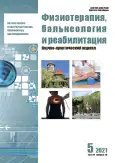The use of microneedling and laser therapy in patients with involutive skin changes
- Authors: Kruglova L.S.1, Avagumyan M.A.1, Tamrazova A.V.1
-
Affiliations:
- Central State Medical Academy of the Presidential Administration of the Russian Federation
- Issue: Vol 20, No 5 (2021)
- Pages: 397-404
- Section: Original studies
- URL: https://journals.rcsi.science/1681-3456/article/view/107862
- DOI: https://doi.org/10.17816/rjpbr107862
- ID: 107862
Cite item
Abstract
BACKGROUND: Involutive skin changes are an urgent problem in the modern world, which leads to the need to find a comprehensive and effective treatment method aimed at reducing the activity of matrix metalloproteinases (MMPs) and transforming growth factor-β2 (TGF-β2), which are responsible for the degradation of extracellular matrix proteins.
AIMS: Determination of the degree of influence of microneedling monotherapy, fractional laser, as well as a combination of these methods on the content of MMP-2, MMP-3, MMP-12, TGF-β2 in the skin of patients with involutive signs.
MATERIAL AND METHODS: In a single-center, prospective, parallel, non-randomized study, 82 patients with involutive changes in the facial skin took part, which were divided into 3 groups. 26 patients (Group 1) received microneedling monotherapy (3 treatments every 3 weeks), 27 patients (Group 2) received fractional laser monotherapy (3 treatments every 4 weeks) and 29 patients (Group 3) combined therapy of microneedling and fractional laser (3 procedures every 4 weeks). The study lasted 10 weeks, before and after the start of the study, a biopsy of the skin behind the ear was taken to determine the level of MMP-2, -3, -12 and TGF-β2.
RESULTS: Comparative data of enzyme immunoassay with biotin monoclonal conjugates between the groups revealed a difference in the content of matrix metalloproteinases and TGF-β: in group 1, there was less significant dynamics in all studied parameters compared to group 3: MMP-2 (p=0.0390), MMP-3 (p=0.0466), MMP-12 (p=0.0104) and TGF-β (p=0.0080) and 2 group MMP-12 (p=0.0484) and TGF-β (p=0.0367). When comparing groups 2 and 3, more significant dynamics was observed in group 3 in terms of MMP-2 (p=0.0290), MMP-12 (p=0.0511) and TGF-β (p=0.0241). Thus, the most significant results were obtained in group 3.
CONCLUSION: Combined treatment using microneedling and fractional laser leads to a significant decrease in the level of MMP-2, -3, -12 and TGF-β2, which allows us to consider this therapeutic complex as a promising way to correct involutive skin changes.
Full Text
##article.viewOnOriginalSite##About the authors
Larisa S. Kruglova
Central State Medical Academy of the Presidential Administration of the Russian Federation
Email: kruglovals@mail.ru
ORCID iD: 0000-0002-5044-5265
SPIN-code: 1107-4372
MD, Dr. Sci. (Med.), Professor
Russian Federation, MoscowMariya A. Avagumyan
Central State Medical Academy of the Presidential Administration of the Russian Federation
Email: maruya-kamalova@yandex.ru
ORCID iD: 0000-0003-1898-678X
Russian Federation, Moscow
Anait V. Tamrazova
Central State Medical Academy of the Presidential Administration of the Russian Federation
Author for correspondence.
Email: anaittamrazova@gmail.com
ORCID iD: 0000-0002-4672-697X
Russian Federation, Moscow
References
- Puizina-Ivić N. Skin aging. Acta Dermatovenerol Alp Pannonica Adriat. 2008;17(2):47–54.
- Chen B, Li R, Yan N, et al. Astragaloside IV controls collagen reduction in photoaging skin by improving transforming growth factor-β/Smad signaling suppression and inhibiting matrix metalloproteinase-1. Mol Med Rep. 2015;11(5):3344–3348. doi: 10.3892/mmr.2015.3212
- Jiang X, Ge H, Zhou C, et al. The role of transforming growth factor β1 in fractional laser resurfacing with a carbon dioxide laser. Lasers Med Sci. 2014;29(2):681–687. doi: 10.1007/s10103-013-1383-5
- Tarasova OV, Kruchinskaya MG, Avagumyan MA. Analysis of the distribution of polymorphisms of the genes MMP 1, XRCC1, HFE(2), GST in patients with involutive skin changes depending on the morphotype. Kremlin Med. Clin Bulletin. 2018(4):168–174. (In Russ).
- Doucas V, Shi Y, Miyamoto S, et al. Cytoplasmic catalytic subunit of protein kinase A mediates cross-repression by NF-kappa B and the glucocorticoid receptor. Proc Natl Acad Sci USA. 2000;97(22):11893–11898. doi: 10.1073/pnas.220413297
- Alexiades-Armenakas MR, Dover JS, Arndt KA. Fractional laser skin resurfacing. J Drugs Dermatol. 2012;11(11):1274–1287.
- Fernandes D, Signorini M. Combating photoaging with percutaneous collagen induction. Clin Dermatol. 2008;26(2):192–199. doi: 10.1016/j.clindermatol.2007.09.006
- Patil UA, Dhami LD. Overview of lasers. Indian J Plast Surg. 2008;41(Suppl):101–113.
- Fernandes D. Minimally invasive percutaneous collagen induction. Oral Maxillofac Surg Clin North Am. 2005;17(1):51–63. doi: 10.1016/j.coms.2004.09.004
- Orentreich DS, Orentreich N. Subcutaneous incisionless (subcision) surgery for the correction of depressed scars and wrinkles. Dermatol Surg. 1995;21(6):543–549. doi: 10.1111/j.1524-4725.1995.tb00259.x
Supplementary files







